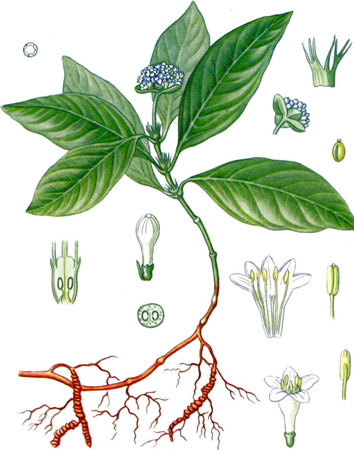Ipecac common – Cephaelis ipecacuanha Willd.
Small evergreen shrub up 40 see family Rubiaceae (Rubiaceae). Grows in Brazil, India and Indonesia. Medical raw material are the roots.

Ipecac common – chemical structure
The roots contain a large amount of ipecac alkaloids (emetine, ametamin, protoэmetin, tsefaэlyn, psyhotryn), glycoside ipekakuanin, and saponins, phytosterol, mix, malic and citric acids.
Ipecac common – Pharmacological properties
The amount of the active ingredients of ipecac in small doses, increases the secretion of bronchial glands, liquefies phlegm and increases the activity of the villi of the ciliated airway epithelium. In large doses, dosage forms plant strongly irritate the mucous membrane of the stomach, in connection with which there is vomiting preceded her long period of sickness.
In the experimental study, isolated from the roots of ipecac main alkaloid emetine found, that the introduction of his dogs in small doses causes vomiting, while when administered parenterally alkaloid or cutting of the vagus nerve even large doses of emesis in animals not cause. With these experiments clearly demonstrated the occurrence of conditioned reflex vomiting when using the roots of ipecac and emetine.
Besides, emetine has a chemotherapeutic effect on the pathogen amoebic dysentery and other protozoa.
Ipecac common – medical applications
Herbal medicines from the roots of ipecac is used as expectorants. As ipecac emetic drugs are rarely used, as the yield on the effects of other plant compounds – Apomorphine.
The therapeutic effect is due to ipecac expectorant, the ability to enhance the secretory function of the bronchial glands and phlegm. Preparations plants are used in acute and chronic inflammatory diseases of the respiratory tract, with poor education mucous secretion in the bronchi, trachea and larynx, in connection with which patients have difficulty with the expectoration of viscous mucus.
In the appointment of ipecac sputum thickens, increases its secretion, improves expectoration products, resulting in inflammation of the mucous membranes of the respiratory system.
Preparations plants provide long mild expectorant action and have a significant advantage over other expectorants due to slower absorption, causes prolonged effect.
Ipecac common – Dosage Forms, Dosing and Administration
Dry extract of ipecac used for the preparation of water infusions by dissolving the extract in water (1 part of the extract of ipecac matches 1 part of the root), as well as for the preparation of alcohol tinctures.
Infusion of ipecac designate an adult to 1 tablespoon (0,4-0.5 Grams per 180 ml), Children up to 12 for months to 1 teaspoon of tincture 0,12 d of 100 ml, Older children - by 1 dessert spoon of 0.15-0.2 g 100 ml 3-5 times a day.
Higher doses and root dry extract of ipecac as an expectorant for adults: single 0,1 g, daily 0,4 g.
Higher doses and root dry extract of ipecac as an expectorant in children:
- aged 6 Months: single 0,005 g, daily 0,02 g;
- from 6 Months before 2 years: single 0,01 g, daily 0,04 g;
- 3-4 Years: single 0,015, daily 0,06 g;
- 5-9 Years: single 0,02 g, daily 0,08 g;
- 10-14 Years: single 0,025 g, daily 0,1 g.
As an emetic prescribed for adults 0.25-0.5 g per reception; The highest single dose of an adult, 1 g (single).
Tincture of ipecac prepared by percolation, applying 70 % alcohol (1 often large- crushed root of ipecac on 10 parts of alcohol). In the absence of ipecac root tincture can be prepared from dried extract of ipecac (1 part) by dissolving it in 70 % alcohol (9 parts).
Tincture of ipecac appointed interior 5-10 drops at the reception (adult). Higher doses for adults: single 15 drops, daily 30 drops.
Syrup of ipecac. Structure: tincture of ipecac 1 part, sugar syrup 9 parts. Assign into adults and 2-4 g per reception.
